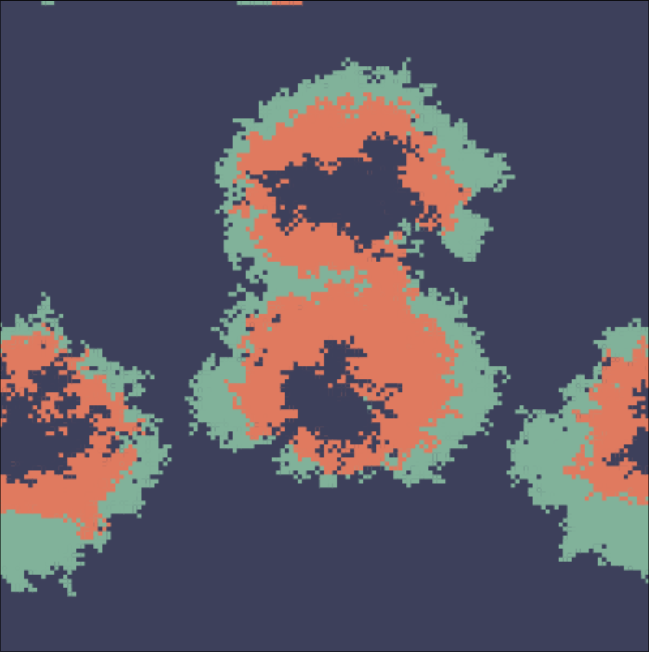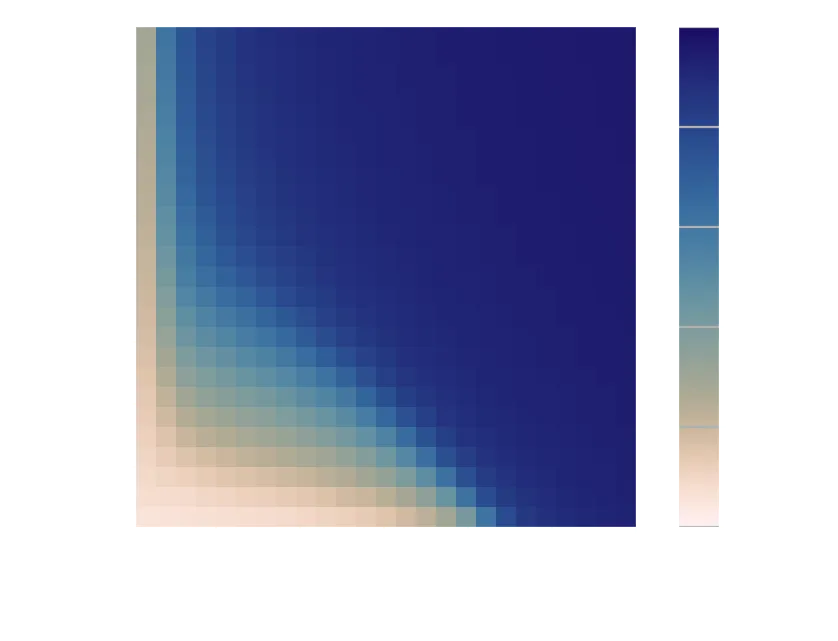· 8 min read
Why are criminals so succesful?
Dive into the complex world of organized crime with insights from complexity science and witness criminal behavior through the interactive simulation.

TLDR
- Unraveling Organized Crime: Complexity science offers a lens to understand the intricate dynamics of organized crime.
- Insightful Model: Explore Perc and colleagues’ model revealing the emergence of criminals and their complex interactions based on various factors.
- Interactive Applet: Dive into the simulation below and witness the spontaneous emergence of criminal behavior based on cost, decision error, and punishment effectiveness.
Crime pays, and it pays very well. The United Nations Office on Drugs and Crime estimates that transnational criminal organizations generate an astonishing annual revenue of approximately $1.6 trillion, equivalent to Canada’s Gross Domestic Product. This prompts the question: how are criminal organizations so successful?
It is crucial to recognize that organized crime is nothing new. Crime occurs in vastly different societies across the globe and can be traced back far in recorded history, making it a common occurrence in society.
However, organized crime remains a significant threat to our societies by undermining the rule of law, social stability, and public safety.
Organized crime sets itself apart from other forms of crime by forming persistent groups that co-offend over time. These groups are difficult to combat as they often operate in multiple jurisdictions, making it harder for law enforcement to coordinate efforts to convict these individuals. The “organized” aspect directly challenges the ruling seat of power, creating a power struggle for control of resources and cash flow that, in extreme cases, can lead to increased violence and economic instability, resulting in wealth disparities.
Traditionally, crime has been studied from an empirical perspective. Criminology is concerned with depicting how crime changes as a function of geographic location, demographic composition, time, and other factors. These approaches produce a highly detailed, often anthropocentric view of crime and its effects on societies. Over time, scientists have constructed various theories to explain why crime occurs.
One of the most interesting theories is to consider criminal organizations not as a set of bandits scheming to produce mayhem, but rather as highly skilled businesspeople. This economic perspective places the individual at the center, where they may weigh the costs and benefits of pursuing a criminal career. Importantly, this perspective serves as a basis to study the computational conditions under which criminal organizations can thrive or falter — a topic of my research.
The field of computational science is still in its early stages, with few scientists attempting to capture the complex nature of human-human interactions in computational models. These models often simplify intricate details to study a reduced problem that hopefully qualitatively captures the dynamics of criminal organizations.
An early approach was conducted by Perc and colleagues, who studied the interaction between criminals, ordinary people, and law enforcement. The introduction of roles is crucial as criminal organizations exist by virtue of the supply and demand created by non-criminal actors. Thus, we can see crime in society as a three-way interaction between criminals, law enforcement, and ordinary people.
Perc and colleagues applied evolutionary game theory to study the relationship between law enforcement, criminals, and law-abiding citizens [1]. This approach considers a set of rational agents who choose their behaviors based on the actions of other agents they interact with. When applied to crime, this means that individuals can decide to become criminals, join law enforcement, or remain normal civilians. The choice of behavior is determined by a cost-benefit analysis performed by each agent. An individual can receive a reward
Each entry in equation shows the outcome of an interaction between two individuals, and zero everywhere else. For example, when an ordinary individual interacts with another ordinary individual, they receive a payoff of 0, whereas an ordinary individual interacting with a punisher will receive a reward of
The dynamics of the system evolve by considering that each decision contains some noise, which can be interpreted as the certainty of an individual about their choice. The transition between choosing either strategy aa or bb will depend on the expected payoff an individual anticipates from a random interaction.
A commonly used choice to model the decision between two policies is the logistic function, which maps the domain to the range (0, 1). The domain is given by the expected payoff shown in the table above.
We can implement the model in Python as follows:
python code
import proplot as plt, numpy as np, cmasher as cmr, pandas as pd
from scipy import integrate
from tqdm import tqdm
from itertools import product
def getPayoff_vectorized(state, alpha, beta, gamma):
o, c, p = state
z = np.sum(state)
payoffs = np.array([
-beta * o * c,
beta * c * o + (beta - 1) * c * p,
gamma * c * p - alpha * p
])
return payoffs
def replicator_dynamics(t, state, alpha, beta, gamma):
payoffs = getPayoff_vectorized(state, alpha, beta, gamma)
phi = np.dot(state, payoffs) # average fitness
dstate_dt = state * (payoffs - phi)
assert np.abs(np.sum(dstate_dt)) < 1e-5, f"Sum of changes: {np.sum(dstate_dt)}"
return dstate_dt
def simulate(settings):
alpha = settings.get("alpha", 0.5)
temptation = np.linspace(0.01, 1.2, 25)
inspectionCost = np.linspace(0.01, 2, 25)
gamma = 1
t_span = settings.get("t_span", (0, 10))
t = np.linspace(*t_span, 100)
x0 = settings.get("x0", np.ones(3) / 3) # We only need initial values for x and y
df = [{} for _ in range(temptation.size * inspectionCost.size)]
for idx, (beta, alpha) in tqdm(enumerate(product(temptation, inspectionCost))):
res = integrate.solve_ivp(
replicator_dynamics,
t_span=t_span,
y0=x0,
args=(alpha, beta, gamma),
t_eval=t,
dense_output=True
)
df[idx] = dict(
beta=beta,
gamma=gamma,
alpha=alpha,
y=res.y,
)Note that this implementation does not use the nearest neighbor interaction as shown in the applet above. The applet at the top of this post follows the model specified by Perc and colleagues. Regardless, we can probe the effect of the cost-to-benefit by systematically varying

Varying the cost-to-benefit reveals a rich “phase diagram” in which criminals, ordinary people and punishers can co-exist (light shaded) or criminals and punishers remain or just criminals exist (blue). Shown are the results for
Figure 1 illustrates a complex phase diagram that emerges when varying the cost-to-benefit ratio within a population comprising criminals, ordinary people, and punishers. The diagram reveals three distinct regions based on the interactions among these groups. In the orange/green region, all three groups co-exist, indicating a dynamic balance where each type maintains a presence. The purple area shows a scenario where only criminals and punishers remain, suggesting that ordinary people are either eliminated or assimilated into the other groups. Finally, the blue region represents a situation dominated solely by criminals, where neither ordinary people nor punishers can sustain their populations. These results are derived under the conditions where both
The co-existent phase reveals the circular nature of the dynamics in which a gain of one population may cause a similar increase in another which then leads to a shift that oscillates over time.

Oscillations can occur in the three populations. Shown are the results for
Criminal organizations are so successful in part due to their ability to operate as rational economic actors within complex societal systems. By examining organized crime through an economic and computational lens, we gain crucial insights into why these groups persist and maintain their significant societal impact. Viewing criminal behavior as a series of rational, cost-benefit driven decisions helps explain the intricate relationships between criminals, law enforcement, and ordinary citizens that contribute to their success.
Although simplified, economic models provide a powerful framework for predicting and understanding the factors that allow criminal organizations to thrive. As computational science progresses, it continues to unravel the complexities of human behavior, shedding light on why these illicit groups are able to adapt and prosper despite efforts to combat them.
The success of criminal organizations can be further explored through interactive applets that allow users to adjust various parameters and observe how changes in the environment affect the dynamics between criminals and society. By experimenting with these models, we can better understand the conditions that enable criminal groups to flourish and potentially develop more effective strategies to counteract their success and foster safer, more stable societies.
References
- [1] Matjaž Perc, Karsten Donnay, and Dirk Helbing. “Understanding Recurrent Crime as System-Immanent Collective Behavior”. In: PLOS ONE 8.10 (Oct. 4, 2013), e76063. issn: 1932-6203. doi: 10.1371/journal. pone.007606



